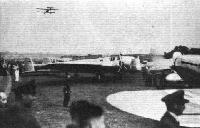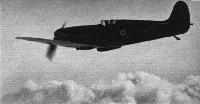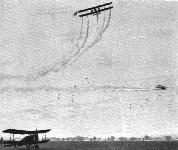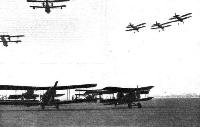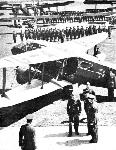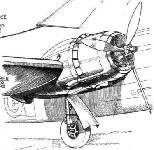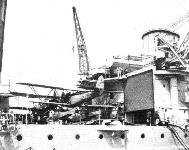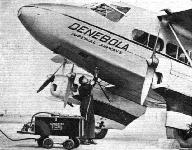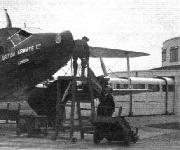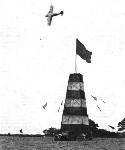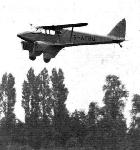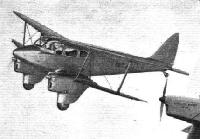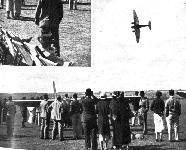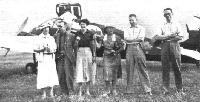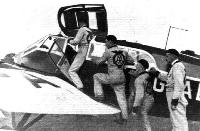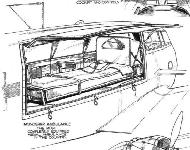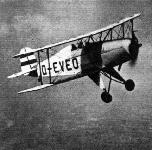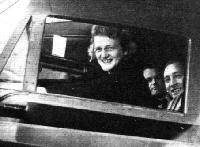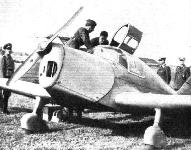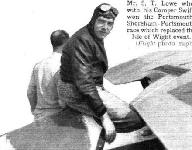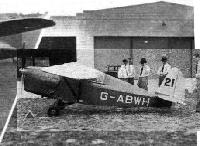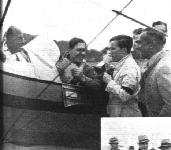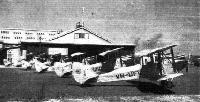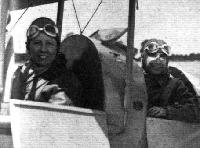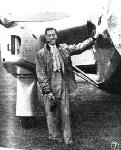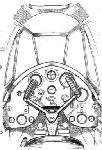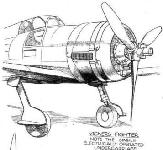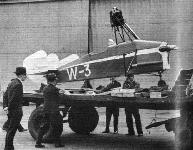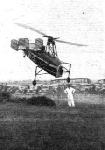Фотографии
-
Регистрационный номер: K4586, K5083 [2] The leisurely passage of the ancient Farman over the new types park. In the foreground the Merlin in the Hawker F.36/34 is being run up. The Whitley heavy bomber is seen in the centre.
Самолёты на фотографии: Armstrong Whitworth Whitley / A.W.38 - Великобритания - 1936Farman Farman-30/40 - Франция - 1915Hawker Hurricane - Великобритания - 1935
-
It is obvious that the Whitley is related to the A.W.23 bomber transport.
Самолёты на фотографии: Armstrong Whitworth Whitley / A.W.38 - Великобритания - 1936
-
The Armstrong Whitworth Whitley, with two Siddeley Tiger engines, is in the heavy bomber class and of modern design.
Самолёты на фотографии: Armstrong Whitworth Whitley / A.W.38 - Великобритания - 1936
-
Armstrong Whitworth Whitley. The tail of the new bomber
Самолёты на фотографии: Armstrong Whitworth Whitley / A.W.38 - Великобритания - 1936
-
Регистрационный номер: K4240 [4] INTERCEPTOR FASHION: The climb of the new Handley Page medium bomber, in this striking picture, suggests the fighter of not so very many years ago.
Самолёты на фотографии: Handley Page Hampden / H.P.52 - Великобритания - 1936
-
Регистрационный номер: K4240 [4] SLIM AND DARK: Off the ground, and with wheels retracted, the new Handley Page medium bomber (two Pegasus engines and C.P. airscrews) has a sinister beauty of line. For this photograph - the first taken with wheels up - the machine was "posed" by Capt J. B. L. H. Cordes, the makers' chief test pilot.
Самолёты на фотографии: Handley Page Hampden / H.P.52 - Великобритания - 1936
-
Регистрационный номер: K4240 [4] PRESENTED TO HIS MAJESTY. This view of the King studying the retractable undercarriage on the new Handley Page medium bomber during his visit to Martlesham last week is but another illustration of His Majesty's genuine interest in things aeronautical.
Самолёты на фотографии: Handley Page Hampden / H.P.52 - Великобритания - 1936
-
Регистрационный номер: K4240 [4] Handley Page medium bomber (two views).
Самолёты на фотографии: Handley Page Hampden / H.P.52 - Великобритания - 1936
-
Handley Page B 9/32. Retractable undercarriage
Самолёты на фотографии: Handley Page Hampden / H.P.52 - Великобритания - 1936
-
Регистрационный номер: K5083 [2] Самолёты на фотографии: Hawker Hurricane - Великобритания - 1935
-
THE GOLDEN ROAD: A D.L.H. Ju 52 on the tarmac at Baghdad airport. This machine was used last month for a trial flight between Berlin and Teheran, Iran, a route which may be reopened by D.L.H. in the near future.
Самолёты на фотографии: Junkers Ju.52/3m - Германия - 1931
-
Регистрационный номер: K5054 The Supermarine Spitfire.
Самолёты на фотографии: Supermarine Spitfire - Великобритания - 1936
-
A Dewoitine D.500 fighter (650 h.p. Hispano Suiza X engine); a type which figured prominently at the Le Bourget Meeting. This machine, and a similar type with 860 h.p. Hispano Y cannon engine, are the latest standard equipment of French fighter squadrons. The D.500 is capable of 231 m.p.h. at 15,580 ft, and is armed with two machine guns.
Самолёты на фотографии: Dewoitine D.500 / D.510 - Франция - 1932
-
Регистрационный номер: K4303 Three of the Fairey Battle's notable features are apparent here. They are the V.P. airscrew, the new "glasshouse" and the flaps.
Самолёты на фотографии: Fairey Battle - Великобритания - 1936
-
Fairey Battle. The cruciform section at the tail
Самолёты на фотографии: Fairey Battle - Великобритания - 1936
-
Fairey Battle. The revised cockpit enclosure
Самолёты на фотографии: Fairey Battle - Великобритания - 1936
-
An almost perfect reconstruction - Mr. R. O. Shuttleworth's Bleriot, with a genuine three-cylinder Anzani engine. It took off and flew a short straight.
Самолёты на фотографии: Bleriot Bleriot-XI - Франция - 1909
-
Регистрационный номер: G-AEGR The limit man (Flt. Lt. Bonham-Carter, with Lady Hoare as passenger) shows deep interest in Mr. Reynold's flag at the start of Saturday's final. The machine is a standard Miles Hawk Major.
Самолёты на фотографии: Miles Hawk / M.2 - Великобритания - 1932
-
Phillips and Fowis were represented by the Hawk Trainer, the Nighthawk, and the Miles Whitney Straight, all fitted with Gipsy engines.
Самолёты на фотографии: Miles Hawk / M.2 - Великобритания - 1932Miles Nighthawk M.7 / Mentor M.16 - Великобритания - 1935Miles Whitney Straight / M.11 - Великобритания - 1936
-
Fft. Lt. Tommy Rose in his Hawk Speed Six, with Gipsy Six R engine, puts in at Shoreham during the eliminating contest on Friday.
Самолёты на фотографии: Miles Hawk / M.2 - Великобритания - 1932
-
Регистрационный номер: G-ADNO [3] W. Humble (Hawk Speed Six) taxies in at Shoreham on Friday behind Waight's fascinating little T.K.2.
Самолёты на фотографии: De Havilland Technical School T.K.2 - Великобритания - 1935Miles Hawk / M.2 - Великобритания - 1932
-
Регистрационный номер: G-ACTE The Hawk Speed Six.
Самолёты на фотографии: Miles Hawk / M.2 - Великобритания - 1932
-
The latest design of Miles undercarriage fairing seen on the Sparrow Hawk.
Самолёты на фотографии: Miles Hawk / M.2 - Великобритания - 1932
-
Регистрационный номер: G-ADLC Types of competing machines: Miles Falcon
Самолёты на фотографии: Miles Falcon M.3 / Hawcon M.6 - Великобритания - 1934
-
Weaving a plait in smoke - the Bulldogs of No. 54 (F) Squadron.
Самолёты на фотографии: Bristol Bulldog - Великобритания - 1927
-
The Farman Horice - so called because it combined the features of the Henry and the Maurice.
Самолёты на фотографии: Farman Farman-30/40 - Франция - 1915
-
The reconstructed Wright biplane (seen being taxied along in front of the enclosures) was not too perfect a replica of the original.
Самолёты на фотографии: Wright Flyer - США - 1903
-
A sentry watches an aeroplane probably older than himself - the Antoinette monoplane of 1909-1911.
Самолёты на фотографии: Antoinette Antoinette - Франция - 1908
-
The trusty old Virginias' only (and probably last) Hendon Display item - parachute escapes by the "crews" of bombers attacked and set on fire by Gauntlets of No. 111 (F) Squadron; note the war-time S.E.5a on the ground.
Самолёты на фотографии: Gloster Gauntlet - Великобритания - 1929RAF S.E.5 - Великобритания - 1916Vickers Virginia - Великобритания - 1922
-
The old and the new: Gloster Gauntlets over two equally famous fighters from another epoch - the Bristol Fighter and the S.E.5s.
Самолёты на фотографии: Bristol F.2A/F.2B Fighter - Великобритания - 1916Gloster Gauntlet - Великобритания - 1929RAF S.E.5 - Великобритания - 1916
-
Регистрационный номер: K6127 CO-OPERATIVE: Ths new Westland army co-operation machine, being slotted and flapped, takes off and lands with conspicuous ease. At the moment the engine is one of the new poppet-valve Mercuries, but a sleeve-valve Perseus will eventually be substituted.
Самолёты на фотографии: Westland Lysander - Великобритания - 1936
-
Westland A 39/34. The rear cockpit enclosure slides on rails
Самолёты на фотографии: Westland Lysander - Великобритания - 1936
-
Westland A 39/34. Slots, flaps and cantilever undercarriage are features
Самолёты на фотографии: Westland Lysander - Великобритания - 1936
-
A machine of their war-story thrillers come to life! Schoolchildren on the day before the Display clustering eagerly round the Sopwith triplane.
Самолёты на фотографии: Sopwith Triplane - Великобритания - 1916
-
The leading Heyford zooms after making its shot at the skittles. Two bombs can just be discerned falling from another machine
Самолёты на фотографии: Handley Page Heyford / H.P.38 / H.P.50 - Великобритания - 1930
-
The scene at Mildenhall on the arrival of the King, with a background of Hinds and Heyfords.
Самолёты на фотографии: De Havilland Dragon Rapide / Dominie / D.H.89 - Великобритания - 1934Handley Page Heyford / H.P.38 / H.P.50 - Великобритания - 1930Hawker Hind - Великобритания - 1934
-
Регистрационный номер: CF-AVJ UBIQUITOUS: A D.H. Dragon Rapide, used by Canadian Airways on the daily Seattle-Vancouver service, parked in front of the administration building, Boeing Field, Seattle, Wash. An interesting feature of this Rapide is the increased fin area necessary when floats are fitted. The other machines will be recognised as a Lockheed Electra 10A of Northwest Airlines and a Boeing 247D of United Air Lines.
Самолёты на фотографии: Boeing Model 247 - США - 1933De Havilland Dragon Rapide / Dominie / D.H.89 - Великобритания - 1934Lockheed Electra 10 - США - 1934
-
Регистрационный номер: K7556 MARTLESHAM'S GREAT DAY: It must have been extremely gratifying to Martlesham that the King should show such interest in the work of the station and in some of the very latest military machines now on test there. In this view, His Majesty, after inspecting the Vickers Wellesley, is passing to the next machine in the line-up,
Самолёты на фотографии: Vickers Wellesley - Великобритания - 1935
-
Регистрационный номер: K4049 The Vickers medium bomber.
Самолёты на фотографии: Vickers Wellington / Type 271 - Великобритания - 1936
-
Vickers Medium Bomber. The "sting" in the tail is temporarily concealed
Самолёты на фотографии: Vickers Wellington / Type 271 - Великобритания - 1936
-
Vickers Medium Bomber. Showing the flaps for controllable cooling
Самолёты на фотографии: Vickers Wellington / Type 271 - Великобритания - 1936
-
Регистрационный номер: G-ACWF [2] The C.30 Autogiro with two-bladed rotor and autodynamic rotor head. The view on the left, showing the take-off, gives the impression that the machine is almost without visible means of support. Mr. H. A. Marsh was the pilot.
Самолёты на фотографии: Cierva/Avro C.30A / Rota - Великобритания - 1932
-
Регистрационный номер: G-ACWF [2] MORE JUMPS: A vertical take-off by the latest C.30 Autogiro. Various components of this experimental machine are heavier than they need be, with the result that the gross weight is the same as that of the ordinary C.30 fully loaded. In spite of this, jumps of forty feet in height have been made.
Самолёты на фотографии: Cierva/Avro C.30A / Rota - Великобритания - 1932
-
AT SINGAPORE: His Highness the Sultan of Johore about to fly as passenger in an Audax with Sqn. Ldr. L. H. Flinn, Royal Air Force Station, Singapore. It will be remembered that last year His Highness made a gift of ?500,000 for Imperial Defence, of which ?100,000 will be devoted to the construction of buildings for the Straits Settlements Volunteer Air Force, of which Sqn. Ldr. Flinn is O/C.
Самолёты на фотографии: Hawker Audax - Великобритания - 1931
-
Hawker Audaxes dropping supplies by parachute in the Army Cooperation event - nine machines each dropped two 150 lb. containers, which would mean over a ton of supplies in all
Самолёты на фотографии: Hawker Audax - Великобритания - 1931
-
PLAN FORM: One of the new Fokker C.X light general purpose biplanes (Rolls Royce Kestrel V) for the Dutch Army Air Service on a quiet, comfortable test flight above typical Netherlands country. These machines do just on 200 m.p.h. and climb to 16,400 ft. in about 10 minutes.
Самолёты на фотографии: Fokker C.X - Нидерланды - 1934
-
REPULSIVE ARMAMENT: A Fairey Swordfish and a Blackburn Shark are now carried on the battle cruiser Repulse. They are housed in special hangars, one of which is visible in this view.
Самолёты на фотографии: Blackburn Shark / B-6 - Великобритания - 1933
-
Blackburn Shark. The new cockpit enclosure in two positions
Самолёты на фотографии: Blackburn Shark / B-6 - Великобритания - 1933
-
A GAY CO-OPERATIVE GORDON: This picture from an Asiatic desert is probably the first of a Fairey Gordon general-purpose machine equipped with a hook for collecting messages from ground forces. The verticals (sometimes formed on actual service by rifles with their bayonets stuck in the ground) seem reluctant to part with the message.
Самолёты на фотографии: Fairey Gordon / Seal - Великобритания - 1931
-
Visitors from the seas: the Saro London, two Short Singapore IIIs (centre) and the Supermarine Stranraer.
Самолёты на фотографии: Saunders-Roe London / A.27 - Великобритания - 1934Short Singapore III / S.19 - Великобритания - 1934Supermarine Stranraer - Великобритания - 1934
-
Регистрационный номер: K3973 SEAFARER: The first machines of a batch of Supermarine Stranraer flying boats will soon be seen at Southampton. This is the latest version of the prototype, with 840 h.p. Pegasus Xs in place of the earlier IIIs, and three-bladed Fairey airscrews.
Самолёты на фотографии: Supermarine Stranraer - Великобритания - 1934
-
Регистрационный номер: K6174 The Avro Anson (two Siddeley Cheetahs) is a general reconnaissance type now equipping R.A.F. general reconnaissance squadrons.
Самолёты на фотографии: Avro Anson / Type 652 - Великобритания - 1935
-
IN MALAYA: Vickers Vildebeest aircraft of No. 36 (Torpedo - Bomber) Squadron flying over the country round Singapore.
Самолёты на фотографии: Vickers Vildebeest / Type 132 - Великобритания - 1928
-
THE KING'S BIRTHDAY AT MALTA: A squadron of Vickers Vildebeests flying past H.E. the Governor, Sir Charles Bonham-Carter.
Самолёты на фотографии: Vickers Vildebeest / Type 132 - Великобритания - 1928
-
His Majesty at the controls of the Bristol 130 bomber-transport monoplane at Martlesham.
Самолёты на фотографии: Bristol Bombay / Type 130 - Великобритания - 1935
-
Регистрационный номер: G-ADDD, AW116 THE ROYAL RAPIDE: A new private aerodrome is being prepared for the King at Smith's Lawn, Windsor. This is the D.H.89 at present owned by His Majesty, and the photograph shows it on the compass base at Hatfield. G-ACTT, the other D.H.89 used by His Majesty when Prince of Wales, was sold some time ago to Olley Air Service.
Самолёты на фотографии: De Havilland Dragon Rapide / Dominie / D.H.89 - Великобритания - 1934
-
Регистрационный номер: K3453 Ready for the afternoon's work. The Tutors are lined up and instructors ani members are just going up for solo or dual flights.
Самолёты на фотографии: Avro Tutor/Sea Tutor/Prefect / Type 621/646/626 - Великобритания - 1929
-
Регистрационный номер: G-ADEB NIGHT MAIL: This country's first real night mail service was opened by British Airways on Monday. Leaving Gatwick at 10 o'clock, the mails reach Stockholm at 8.20 on the following morning. For the moment they are carried by A.B. Aerotransport from Hanover.
Самолёты на фотографии: De Havilland Express Air Liner / D.H.86 - Великобритания - 1934
-
A Dagenite ground-starting trolley in use by Imperial Airways. Its twelve-volt batteries are capable of 489 10-second "starts" at 100 amperes on one charge.
Самолёты на фотографии: De Havilland Express Air Liner / D.H.86 - Великобритания - 1934
-
MAILS TO STOCKHOLM: On Wednesday of last week the first direct mail service to Stockholm was opened by British Airways. The machine left Gatwick with passengers and 1,000 lb. of mail.
Самолёты на фотографии: De Havilland Express Air Liner / D.H.86 - Великобритания - 1934
-
De Havilland 86A. Miniature stabilising fins
Самолёты на фотографии: De Havilland Express Air Liner / D.H.86 - Великобритания - 1934
-
Регистрационный номер: G-ADNA The D.H. Dragonfly (the only biplane in the race) took its turns in grand style. This view also shows the nature of the Sacombe pylon.
Самолёты на фотографии: De Havilland Dragonfly / D.H.90 - Великобритания - 1935
-
Регистрационный номер: G-AEBU The D.H. Dragonfly gave an impressive demonstration of flying with one engine stopped completely.
Самолёты на фотографии: De Havilland Dragonfly / D.H.90 - Великобритания - 1935
-
Types of competing machines: D.H. Dragonfly
Самолёты на фотографии: De Havilland Dragonfly / D.H.90 - Великобритания - 1935
-
The Monospar is being demonstrated by Mr. Seth-Smith while the interested spectators engulf Mr. Lowe's Swift
Самолёты на фотографии: Comper Swift / CLA.7 - Великобритания - 1930General Aircraft Monospar ST-25 Universal - Великобритания - 1935
-
A group of participants: Miss de Paula, Mr. D. R. Pobjoy, Miss Cleyton, Mrs. Pobjoy, Mr. Whitton and Mr. Jackson. In the background is the Monospar S.T.25 (two Pobjoys) flown by Mr. C. E. Gardner. Incidentally, this machine returned in one day, leaving Budapest at 7.45 a.m. and reaching Lympne at 5.45 p.m.
Самолёты на фотографии: General Aircraft Monospar ST-25 Universal - Великобритания - 1935
-
Регистрационный номер: G-AEDY General Aircraft was represented by the standard type 25 and the Monospar Ambulance, Florence Nightingale, both with Pobjoy Niagara engines.
Самолёты на фотографии: General Aircraft Monospar ST-25 Universal - Великобритания - 1935
-
THE FLYING SQUAD: Mr. Tapper, of the A.A., used a Monospar S.T.25 to convey his "air scouts" from point to point during the Week-end Aerien, during which event they performed their usual efficient parking and other ground duties.
Самолёты на фотографии: General Aircraft Monospar ST-25 Universal - Великобритания - 1935
-
Monospar Ambulance. The most completely equipped aerial ambulance in the country
Самолёты на фотографии: General Aircraft Monospar ST-25 Universal - Великобритания - 1935
-
Monospar Ambulance. Interior, showing nurses seat and general equipment
Самолёты на фотографии: General Aircraft Monospar ST-25 Universal - Великобритания - 1935
-
Регистрационный номер: K4497, K4499, K4500 [2], K4501, K4503 SYMMETRY in the SKY: An aerial staircase by No. 604: An excellent example of the difficult formation known as "Echelon to the Right, Stepped up."
Самолёты на фотографии: Hawker Demon - Великобритания - 1932
-
Squadron V: The Hawker Demons of the Squadron against a fine background of clouds.
Самолёты на фотографии: Hawker Demon - Великобритания - 1932
-
For Hendon Display purposes: An unusual formation by No. 604 (County of Middlesex) (Fighter) Squadron.
Самолёты на фотографии: Hawker Demon - Великобритания - 1932
-
Регистрационный номер: K4500 [2] The Controlling Demon: Sqn. Ldr. Gabriel and his Familiar Spirit.
Самолёты на фотографии: Hawker Demon - Великобритания - 1932
-
Регистрационный номер: G-AEHJ The Heston Phoenix with Gipsy Six engine is the centre of attraction.
Самолёты на фотографии: Heston Phoenix - Великобритания - 1935
-
Регистрационный номер: G-ADYX A "CLEAN" LIGHTWEIGHT: The new Luton Buzzard being flown by F/O. K. G. Stodart at Luton aerodrome. The machine, which was described in Flight of June 18, has a 34 h.p. British Anzani vee-twin engine.
Самолёты на фотографии: Luton Buzzard - Великобритания - 1936
-
An example of the Gipsy Six Gull
Самолёты на фотографии: Percival Gull - Великобритания - 1932
-
Snugly ensconced in the cockpit of his pet Mew Gull - Capt. Percival in his complete racing outfit, the two major features of which are a trilby and the well-known smile.
Самолёты на фотографии: Percival Mew Gull - Великобритания - 1934
-
The Mew Gull at Shoreham on Friday.
Самолёты на фотографии: Percival Mew Gull - Великобритания - 1934
-
Gardner's victorious Vega Gull taxies in after its grand race.
Самолёты на фотографии: Percival Vega Gull / K.1 - Великобритания - 1935
-
Ministering to Gardner's Vega Gull during the eliminating contest. Refuelling was done with the engine running.
Самолёты на фотографии: Percival Vega Gull / K.1 - Великобритания - 1935
-
The Percival "family" was represented at Hatfield by a Gull, a Vega Gull, and a Mew Gull. All three machines have Gipsy engines. The Vega Gull is in the foreground.
Самолёты на фотографии: Percival Vega Gull / K.1 - Великобритания - 1935
-
Регистрационный номер: G-AELE Mr. W. Lindsay Everard's Vega Gull The Leicestershire Fox IV goes to earth at Shoreham. Mr. P. Q. Reiss, its pilot, was turning on the ground when the machine was caught by a gust.
Самолёты на фотографии: Percival Vega Gull / K.1 - Великобритания - 1935
-
Регистрационный номер: G-ADHL [7] FOR CIVIL SERVICE: The Short Empire flying boat is powered with four of the new Pegasus Xc civil-rated radials, the official figures for which have just been made known. The international-rated power is 740 h.p. at 3,500 ft., and 910 h.p. is available for take-off with the De Havilland V.P. airscrew. Flaps for controllable cooling are incorporated in the long chord cowlings. This Flight photograph was taken during the second test flight at Rochester.
Самолёты на фотографии: Short Empire / S.23 - Великобритания - 1936
-
Регистрационный номер: G-ADHL [7] One of the hinged platforms used for giving access to the Bristol Pegasus engine.
Самолёты на фотографии: Short Empire / S.23 - Великобритания - 1936
-
Регистрационный номер: G-ADHL [7] Самолёты на фотографии: Short Empire / S.23 - Великобритания - 1936
-
Регистрационный номер: G-ADHL [7] Самолёты на фотографии: Short Empire / S.23 - Великобритания - 1936
-
Регистрационный номер: G-ADHL [7] One of the beaching trolleys.
Самолёты на фотографии: Short Empire / S.23 - Великобритания - 1936
-
Регистрационный номер: G-ADHL [7] Самолёты на фотографии: Short Empire / S.23 - Великобритания - 1936
-
Регистрационный номер: G-ADHL [7] For the Empire air routes: The bird's-eye view gives a good idea of the rounded deck, the wing fillets and the trailing-edge flaps of the first of the new boats. The open door leads to the freight and mail hold.
Самолёты на фотографии: Short Empire / S.23 - Великобритания - 1936
-
EMPIRE ROUTE LUXURY: This impressive drawing by an Imperial Airways artist gives a very clear idea of the main accommodation features of the new Short Empire boats. Powered with four Pegasus X engines, the craft are expected to cruise at 150-160 m.p.h. The first of these boats, of which nearly twenty are being built at Rochester, is expected to be launched during the next week or so. A somewhat similar type is to be used as the lower component of the Short-Mayo "composite" aircraft, also being built for Imperial Airways.
Самолёты на фотографии: Short Empire / S.23 - Великобритания - 1936
-
Регистрационный номер: G-ADNO [3] The De Havilland Technical School's T.K.2 in its latest form.
Самолёты на фотографии: De Havilland Technical School T.K.2 - Великобритания - 1935
-
Регистрационный номер: G-ADNO [3] KING'S CUP CAMEOS Caught by the Camera at Hatfield. T.K.2 - and two.
Самолёты на фотографии: De Havilland Technical School T.K.2 - Великобритания - 1935
-
A complete revision of the lines of the upper section of the fuselage added speed and grace to the T.K.2. This sketch shows the new cabin and undercarriage. On the right is the general view of the empennage.
Самолёты на фотографии: De Havilland Technical School T.K.2 - Великобритания - 1935
-
The Wicko Wizard Wicko F. engine (converted Ford V8) or Cirrus Minor
Самолёты на фотографии: Foster Wikner Wicko - Великобритания - 1936
-
Регистрационный номер: F-AOVV PASSENGERS OVER THE ATLANTIC: This is the new Loire 102 (four Hispano 12 XBRS 720 h.p. engines) designed for the Air France South Atlantic service and in which passengers will be carried for the first time. It is expected to be capable of carrying 1,000 kilos on the crossing at a speed of 170 m.p.h. The maximum is 194 m.p.h. and preliminary test flights have already been carried out.
Самолёты на фотографии: Loire Loire 102 Bretagne - Франция - 1936
-
Регистрационный номер: F-ANRU M. Eugene Wittinne's Caudron Simoun, which was flown by M. Vanlaere.
Самолёты на фотографии: Caudron C.500 / C.520 / C.620 / C.630 Simoun - Франция - 1934
-
Регистрационный номер: D-EVEO A GERMAN SINGLE-SEAT TRAINER, the Bucker Jungmeister. Built on rather similar lines to the Bucker Jungman described in Flight of May 28, it is fitted with a more powerful engine - the 140 h.p. six-cylinder Hirth - and has a top speed of 143 m.p.h. The cruising speed is 124 m.p.h. and its landing speed 50 m.p.h. The makers are Bucker-Flugzeugbau G.m.b.H., Rangsdorf bei Berlin.
Самолёты на фотографии: Bucker Bu.133 Jungmeister - Германия - 1935
-
An impressive view of the Focke-Wulf Stosser flown by E. Kropf, the famous German aerobatic pilot, who entertained the visiters at Ratcliffe on Sunday
Самолёты на фотографии: Focke-Wulf FW.56 Stosser - Германия - 1933
-
THE HAMMOND AGAIN: This is the production version of the Hammond Y, one of the "fool-proof" designs which have been built to the U.S. Bureau of Air Commerce orders. It was originally described in Flight of December 6, 1934, and the revised model is reputed to have a maximum speed of 123 m.p.h. The engine is a 125 h . p . Menasco, which may yet be produced in this country.
Самолёты на фотографии: Stearman-Hammond Y-1 - США - 1936
-
Miss Bessie Owen, a visitor from the U.S. (not direct by air), in the cabin of her Waco.
Самолёты на фотографии: WACO C / S Series - США - 1931
-
The hinged nose of the fuselage permits inspection of the flying controls, instruments and other equipment, and attracted a good deal of attention.
Самолёты на фотографии: Short Scion Senior / S.22 - Великобритания - 1935
-
Short Scion Senior. Showing the seating accomodation. The lavatory is amidships
Самолёты на фотографии: Short Scion Senior / S.22 - Великобритания - 1935
-
Short Scion Senior. The power plant installation (Pobjoy Niagaras)
Самолёты на фотографии: Short Scion Senior / S.22 - Великобритания - 1935
-
Short Scion Senior. The well streamlined undercarriage
Самолёты на фотографии: Short Scion Senior / S.22 - Великобритания - 1935
-
The B.A. Eagle. This type will be flown by Mrs. Mollison.
Самолёты на фотографии: British Klemm BK-1 Eagle - Великобритания - 1934
-
TRIPLE ALLIANCE: A Miles Whitney Straight was used by Col. Lindbergh for his visit to Berlin last week. He is seen arriving at Staaken Aerodrome, where, with Mrs. Lindbergh, he was welcomed by Col. Kassner on behalf of General Goering, and by Herr Wolfgang von Gronau, president of the German Aero Club.
Самолёты на фотографии: Miles Whitney Straight / M.11 - Великобритания - 1936
-
Were it not for the rear gunner's turret it would be impossible to distinguish this military version of the Envoy from its civil counterpart. The covered forward gun trough can be seen below the control cabin.
Самолёты на фотографии: Airspeed Envoy / AS.6 - Великобритания - 1934
-
Although actually flying at 10,000 ft above the thunder clouds, Flt. Lt. Colman lowers the undercarriage and flaps of the first South African Envoy for the benefit of Flight's photographer.
Самолёты на фотографии: Airspeed Envoy / AS.6 - Великобритания - 1934
-
Регистрационный номер: K7557 The 143 flying.
Самолёты на фотографии: Bristol Type 142 Britain First / Type 143 - Великобритания - 1935
-
Регистрационный номер: G-ACKP Самолёты на фотографии: De Havilland Leopard Moth / D.H.85 - Великобритания - 1933
-
Регистрационный номер: G-AHAH Mr. Henery's 1 1/2 in. to 1 ft. Leopard; even the instruments are to scale
Самолёты на фотографии: De Havilland Leopard Moth / D.H.85 - Великобритания - 1933
-
Mr. S. T. Lowe who, with his Comper Swift, won the Portsmouth - Shoreham - Portsmouth race which replaced the Isle of Wight event.
Самолёты на фотографии: Comper Swift / CLA.7 - Великобритания - 1930
-
Регистрационный номер: G-ABWH, NC27K, VH-ACG Types of competing machines: Comper Swift.
Самолёты на фотографии: Comper Swift / CLA.7 - Великобритания - 1930
-
Capt. A. von Wirterfeldt, the pilot of the Heinkel Kadett, and Dr. Robert Henschel are welcomed
Самолёты на фотографии: Heinkel He-72 Kadett - Германия - 1933
-
The Potez sesquiplane in which Mile. Hilz (right) obtained her record.
Самолёты на фотографии: Potez Potez 50 - Франция - 1930
-
Регистрационный номер: G-ADPT [2] These remarkable photographs, taken by Mr. W. E. Gray in a B.A. Swallow, show the behaviour of wool tufts on the wing as a stall - incidentally, an extremely innocuous and controllable one - develops.
Самолёты на фотографии: British Klemm L.25 Swallow - Великобритания - 1933
-
Регистрационный номер: G-ADPT [2] Самолёты на фотографии: British Klemm L.25 Swallow - Великобритания - 1933
-
LIVERPOOL LIKES THEM! Members of the Liverpool Aero Club with the two B.A. Swallows of which they hare just taken delivery. In the group are Flt. Lt. G. Clapham (instructor) and Major Nicholls (secretary). Liverpool, incidentally, is the twelfth club to use Swallows.
Самолёты на фотографии: British Klemm L.25 Swallow - Великобритания - 1933
-
Регистрационный номер: VH-UFV, VH-UHQ The N.S.W. Club's fleet in front of the hangar at Mascot.
Самолёты на фотографии: De Havilland Gipsy Moth / Moth X - Великобритания - 1928
-
Mme. P. du Jardin and M. Edmond Leon, who came in the original Moth Major.
Самолёты на фотографии: De Havilland Moth Major / D.H.60GIII - Великобритания - 1932
-
Регистрационный номер: G-AEIN A pleasing "shot" of Flt. Lt. Wilson's Double Eagle coming in at Shoreham on Friday with the stately chapel of Lancing College in the background.
Самолёты на фотографии: British Aircraft BA.IV Double Eagle - Великобритания - 1936
-
Регистрационный номер: G-ADVV [2] Types of competing machines: B.A. Double Eagle
Самолёты на фотографии: British Aircraft BA.IV Double Eagle - Великобритания - 1936
-
Регистрационный номер: G-ADVV [2] The new B.A. Double Eagle with two Gipsy Majors has a very unusual wing arrangement.
Самолёты на фотографии: British Aircraft BA.IV Double Eagle - Великобритания - 1936
-
KING'S CUP CAMEOS Caught by the Camera at Hatfield. A King's Cup veteran - Capt. W. L. Hope. (B.A. Double Eagle), unluckily eliminated by fuel-system trouble on Friday.
Самолёты на фотографии: British Aircraft BA.IV Double Eagle - Великобритания - 1936
-
B. A. Double Eagle. Cockpit and controls
Самолёты на фотографии: British Aircraft BA.IV Double Eagle - Великобритания - 1936
-
The left-hand sketch reveals in detail certain of the features of the B.A. Double Eagle. To the right is a close-up of its retractable undercarriage.
Самолёты на фотографии: British Aircraft BA.IV Double Eagle - Великобритания - 1936
-
B. A. Double Eagle. Moving wing fillet on cabin door
Самолёты на фотографии: British Aircraft BA.IV Double Eagle - Великобритания - 1936
-
Vickers Fighter. Note the simple electrically operated undercarriage
Самолёты на фотографии: Vickers Venom - Великобритания - 1936
-
Самолёты на фотографии: Weir W.3 - Великобритания - 1936
-
Самолёты на фотографии: Weir W.3 - Великобритания - 1936
-
"The Cow Jumped Over the Moon." These pictures from a cine film, secured by Flight's photographer, show ten stages in the take-off of the new Weir Autogiro. The time-lapse between the first (top left) and the last picture is 2 1/4 seconds. Note that at first the machine rises vertically, and then begins to forge ahead.
Самолёты на фотографии: Weir W.3 - Великобритания - 1936
-
Three vertical fins are used for directional stability. The central rudder is fitted for experimental work only.
Самолёты на фотографии: Weir W.3 - Великобритания - 1936
-
The picture of the machine on a lorry gives a good idea of the small size.
Самолёты на фотографии: Weir W.3 - Великобритания - 1936
-
A jump-start by the little Weir W.3. Mr. H. A. Marsh was the pilot.
Самолёты на фотографии: Weir W.3 - Великобритания - 1936
-
In the "office" of the W.3. The central stick is the flying control. In the gate on the left, pulling the lever into the first slot engages the rotor head drive, into the middle slot engages the clutch, and into the left slot applies the wheel brakes. All three are released simultaneously by pressing the button on the front of the gate. The rotor brake is operated by the separate lever below the gate.
Самолёты на фотографии: Weir W.3 - Великобритания - 1936
-
Prince Constantin Soutzo, standing in the cockpit of the Icar Universal
Самолёты на фотографии: ICAR Universal - Румыния - 1934
-
The Icar Universal, being started before a trip to Oxford.
Самолёты на фотографии: ICAR Universal - Румыния - 1934
Статьи
- Flight
- Flight Advertisements
